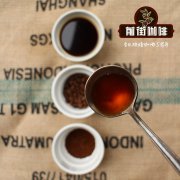Is pepper the defective taste of coffee? What is the smell of defects?
Is pepper resin a blemish taste of coffee?
It doesn't count. In the flavor round division of SCAA (American Fine Coffee Association), pepper flavor belongs to spice flavor, and coffee produced in some areas is characterized by spice flavor. Flavors such as Cunninghamia lanceolata and cedar are also classified as resin flavor. The above all belong to the dry distillation flavor of coffee (details below), not defective taste.
Of course, some friends usually do not like the smell of pepper and cloves, and when drinking coffee containing this flavor, they may think that it is a bad taste in the coffee.
Then what is the smell of defects?
According to the author's understanding, the defective smell of coffee should refer to the smell caused by improper processing or baking, such as smoke, chemicals, leather, meat, etc. and recognized bad taste such as mildew, dust and so on.

Three sources and nine charm
Generally speaking, with the baking degree from shallow to deep, the three sources of ① fermentation, ② caramelization and Maillard reaction, and ③ dry distillation created nine flavors: flower rhyme, fruit rhyme, herbal rhyme, nut rhyme, caramel rhyme, chocolate rhyme, resin rhyme, spicy rhyme and charcoal rhyme.
Enzyme action
Coffee beans are the seeds of coffee. In the process of metabolism, they secrete enzymes to decompose macromolecular substances into small molecular substances. In this process, malic acid, citric acid, tartaric acid and other fruit flavor organic acids and esters are derived.
In the treatment of coffee, whether in the sun or washing, there is a fermentation stage, in which the coffee fruit is decomposed into lactic acid, acetic acid and other organic acids by yeast or bacteria, increasing the sour flavor of the coffee.
For example, anaerobic fermentation, which is very popular in recent years, is used to retain the delicious and aromatic substances of coffee.
Mena reaction and caramelization
Roasting gives full play to the aroma of coffee. Mena reaction refers to a series of degradation and polymerization of monosaccharide carbohydrates and amino acids, which runs through the whole roasting process. Monosaccharides react with amino acids at different temperatures to produce many complex aromas, such as nuts, almonds, cream, chocolate and other aromas from the Mena reaction.
Caramelization is the oxidation and browning of sugars in the process of heating, resulting in aromas such as honey, maple syrup and caramel.
Light roasted coffee has obvious aromas of flowers and fruits, while medium and deep roasted coffee emphasizes aromas such as nutty cocoa caramel.
Important Notice :
前街咖啡 FrontStreet Coffee has moved to new addredd:
FrontStreet Coffee Address: 315,Donghua East Road,GuangZhou
Tel:020 38364473
- Prev

What's the difference between Papua New Guinea coffee and Yerga Shefi?
What is the difference between Papua New Guinea coffee and Yegashev? The independent state of Papua New Guinea, referred to as Papua New Guinea for short, covers an area of 462,800 square kilometers and an area of 3.1 million square kilometers of marine exclusive economic zone. Papua New Guinea is one of the less developed countries in the world. The economy is dominated by agriculture, which accounts for 32 per cent of Papua New Guinea's economy. The main exports are minerals and
- Next

How does Honduras control leaf rust? What are the measures for the treatment of leaf rust in Honduras
The coffee industry was shocked and shocked by the news that Lompilla (formerly thought to be a rust-proof coffee variety) had been infected with rust in Honduras. However, while producers are shocked, Honduras is in a much better position to deal with caffeine rust than it did in 2012, when the last epidemic hit. IHC of the National Coffee Institute of Honduras
Related
- Beginners will see the "Coffee pull flower" guide!
- What is the difference between ice blog purified milk and ordinary milk coffee?
- Why is the Philippines the largest producer of crops in Liberia?
- For coffee extraction, should the fine powder be retained?
- How does extracted espresso fill pressed powder? How much strength does it take to press the powder?
- How to make jasmine cold extract coffee? Is the jasmine + latte good?
- Will this little toy really make the coffee taste better? How does Lily Drip affect coffee extraction?
- Will the action of slapping the filter cup also affect coffee extraction?
- What's the difference between powder-to-water ratio and powder-to-liquid ratio?
- What is the Ethiopian local species? What does it have to do with Heirloom native species?

